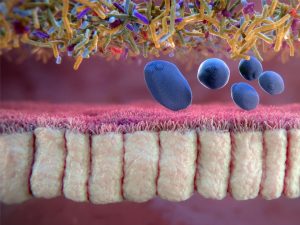
Dysbacteriosis: what can be confused with
Gut bacteria are so small that they cannot be seen without a microscope. But the results of their “work” are so great that even the brain gets under the influence. Modern research finds more and more evidence of how much the “health” of the microbiota affects the health of the whole organism. But the signs of microbial trouble are not striking at all. How to spot problems in time? And what are the masks for dysbiosis?
Microbiota Functions You May Not Know About
1. Enzyme-forming
Intestinal dysbiosis leads to impaired breakdown of glucose, fructose, lactose and more complex carbohydrates. Thus, provoking fermentation processes (flatulence, bloating) and diarrhea, and simulating lactase deficiency and other types of food intolerance.
The intestinal microflora provides invaluable assistance in the digestion of proteins, the breakdown of urea and lipid metabolism, and also affects cholesterol metabolism.
Obviously, violations at this level can be accompanied not only by “harmless” stool disorders, but also by intolerance to fatty foods, impaired fat metabolism, rapid weight gain and changes in blood cholesterol.
2. Protective
Normal intestinal microflora compete for “habitat” with pathogenic flora. In the arsenal of “good” bacteria there is also a weapon from “uninvited guests” in the form of various antimicrobial substances. And the maintenance of such protection is due not only to the quantity, but also to the functional activity of the microbiota.
The decomposition of phenolic compounds by bacteria, which are a strong carcinogen, can also be attributed to the protective function. Therefore, according to modern concepts, imbalance in microflora is associated with the risk of colon cancer, as well as breast cancer.
3. Synthetic
Bifidobacteria of the intestine produce B vitamins (B3, B9, B1, B7 and B12), amino acids and enzymes that ensure their assimilation.
Lactobacillus is the main producer of lactic acid, which maintains the necessary acidity in the intestines and helps the absorption of vitamin D, calcium and iron.
The non-pathogenic E. coli stimulates the synthesis of immunoglobulins, protecting the intestines from infection, and produces anti-cancer agents.
The production of volatile fatty acids by the microflora, which maintain the balance of electrolytes, as well as calcium, zinc and magnesium, is of great importance.
An imbalance at this level is manifested by symptoms:
B-vitamin deficiency (chronic fatigue, emotional lability, depression, irritability, decreased cognitive abilities, neurological symptoms, deterioration of the skin, hair, nails, and so on),
disorders of calcium metabolism (caries, osteoporosis, convulsions),
recurrent anemia,
mild edema due to electrolyte imbalance.
4. Immunogenic
Recent studies demonstrate the strongest influence of normal microflora on the state of immunity in general.
Bifidobacteria and lactobacilli:
stimulate the “maturation” of plasma cells to B-lymphocytes capable of synthesizing antibodies, and maintain their level in the blood;
enhance the phagocytic activity of immune cells;
synthesis of immunoglobulin A,
cytokines,
enhance cellular immunity.
And dysbiotic conditions are associated with severe inflammatory bowel diseases (Crohn’s disease, ulcerative colitis), atopic dermatitis, skin allergies and a decrease in general immunity.
What can be confused with
It is obvious that dysbiosis does not have a single obvious sign of its presence. After all, it is not customary to look for the cause of chronic fatigue and mood swings in the intestines. Allergies are often attributed to heredity, and regular abdominal discomfort is attributed to nutritional errors.
One can only suspect that something was wrong with a careful assessment of the history (taking antibiotics, poor nutrition, poor water quality, stress, unfavorable environmental factors, and many others) and the nature of the symptoms.
The microbiota is able to withstand unfavorable conditions of existence for quite a long time, however, with prolonged exposure to risk factors, the reserves of protection are nevertheless depleted. Therefore, dysbiosis never appears at once (unless we are talking about antibiotics, of course), and its symptoms develop and intensify very slowly. That should definitely be assessed if there are doubts about the nature of the process.
However, no matter how brightly the symptoms appear, it is virtually impossible to make such a “diagnosis” by eye. After all, dysbiosis can be both a cause and a consequence of pathology at the same time.
Analyzes
1. Sowing feces for dysbiosis https://en.wikipedia.org/wiki/Dysbiosis
It has been used in medical practice for many decades, but it allows to estimate only about 50 types of microorganisms living in the lumen of the lower parts of the large intestine, which significantly limits the diagnostic capabilities of the analysis.
2. Determination of microbiocenosis by blood (Osipov method)
The test is based on determining the level of those same volatile fatty acids in the blood, and it allows you to assess more than 200 representatives of the microbial community that live throughout the intestine. However, due to its “youth” and the absence of many years of testing, it has not yet received wide recognition.
Gut bacteria are so small that they cannot be seen without a microscope. But the results of their “work” are so great that even the brain gets under the influence. Modern research finds more and more evidence of how much the “health” of the microbiota affects the health of the whole organism. But the signs…